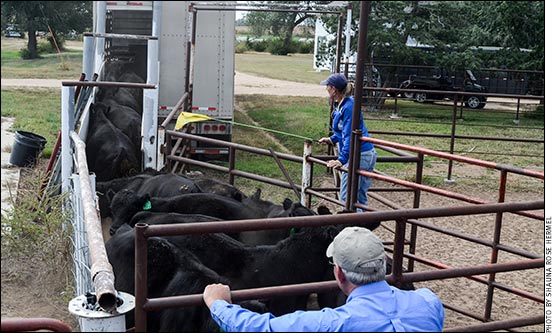
Calm handling and proper loading management can safeguard cattle welfare during transport.
Assessing Transportation Stress
Study reveals the causes of stress and injury during transport.
According to animal behaviorist and scientist Karen Schwartzkopf-Genswein, stress is a physiological response to real or perceived stressors — conditions or events that cause strain, tension, anxiety or pain. Transportation can include a number of stressors, including loading, unloading, commingling with unfamiliar cattle and delivery to an unfamiliar environment. Transportation may involve a period of restriction from feed and water, and discomfort due to heat or cold. Cattle also expend energy maintaining their balance during transportation. The longer the ride, the more tiring it is.

“After 30 hours of transport, animals have lost all the moisture they can stand. I’m recommending that time in transport be limited to 26 hours,” said Schwartzkopf-Genswein, adding that the incidence of “downer” animals increases when time on a trailer exceeds 28 hours.
Schwartzkopf-Genswein, a researcher with Agriculture and Agri-Food Canada, talked about her efforts to better understand transportation stress during the Cattle Transportation Symposium hosted May 14-15, in Fort Collins, Colo. She called it unreasonable for anyone to expect animals to experience a completely stress-free life. However, animal welfare is affected when stress responses shift energy away from normal biological functions.
Schwartzkopf-Genswein explained how she and fellow researchers gathered benchmark data from 2007 through 2009 on cattle transportation in Canada. Her team surveyed more than 6,000 truckers involved in transporting more than 290,000 cattle on long hauls of 400 kilometers (248.5 miles) or more. Of particular interest to researchers were relationships between time in transport and cattle shrink, as well as effects of driver experience.
Cattle folk know that cattle experience shrink or weight loss during transport. Initially, shrink is due to loss of rumen fill, manure and urine. On long hauls additional shrink occurs as a result of tissue moisture loss. Schwartzkopf-Genswein said weight loss due to shrink increases during long periods of transport, but plateaus after 30 hours. She attributes the slower rate of shrink to a depletion of tissue moisture, which can result in tissue damage and seriously threaten animal health.
“After 30 hours of transport, animals have lost all the moisture they can stand. I’m recommending that time in transport be limited to 26 hours,” said Schwartzkopf-Genswein, adding that the incidence of “downer” animals increases when time on a trailer exceeds 28 hours.
The survey also showed a linear relationship between driver experience and the stress cattle experience. Drivers with fewer than five years’ experience were associated with increased levels of shrink and higher incidences of lameness and nonambulatory animals.
However, the most severe problems occurred as a result of stressful handling during loading of trailers and as a result of loading animals that should have been recognized as unfit for transport.
“Even the best drivers cannot compensate for poor loading decisions. An animal’s condition going into the trailer is a big factor,” concluded Schwartzkopf-Genswein.
For more information from the symposium, see articles on the Marketing and Management pages of this Angus Beef Bulletin EXTRA, and see the September Angus Beef Bulletin.

Editor’s Note: Troy Smith is a freelance writer and cattleman from Sargent, Neb.





